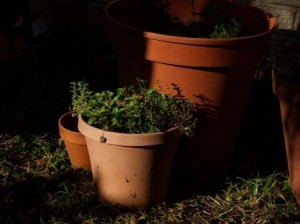How to Grow Herbs in Outdoor Planters
 If you’re interested to know how to grow herbs but you do not have much room to create a regular garden, you can still place planters around your doorway, and other areas. For the most part, apartment dwellers, as well as individuals with small yards may find this method more suitable than trying to create an indoor home herb garden. As long as you select planters that will be suitable for each herb type, you should be able to enjoy plenty of fresh seasoning once the plants mature.
If you’re interested to know how to grow herbs but you do not have much room to create a regular garden, you can still place planters around your doorway, and other areas. For the most part, apartment dwellers, as well as individuals with small yards may find this method more suitable than trying to create an indoor home herb garden. As long as you select planters that will be suitable for each herb type, you should be able to enjoy plenty of fresh seasoning once the plants mature.
Water Drainage
For the most part, you will find that outdoor planters are fairly large. That said, you should still be careful to select a planter that conforms to the basic root shape of the herbs in question. If you are going to plant herbs with large, or deep roots, it will not be of much use to select a shallow planter. Typically, these plants will do better in rounded planters that have a deep curve to them.
Chances are, if you study outdoor planters, you will find that very few have drainage holes. As water collects in the deeper areas of the planter, it can wreak absolute havoc. In some cases, you may want to select planters that are easy to drill holes in. It may also be of some help to make sure that you line the bottom of these planters with gravel and sand. At the very least, this will help keep an even balance to the moisture levels in different parts of the planter.
Heat Retention
Today, you will find an endless number of plastic planters. Depending on the color, some of them may retain heat at excessive levels. For example, if you place a black planter in direct sunlight, it will absorb heat instead of repel it. Under these conditions, plant roots can burn or become dehydrated. Before you purchase more than one planter, you should at least make sure that it will not retain heat and cause damage to plants. If you are having problems choosing between a planter that you can drill holes in, and one that may retain heat, you are better off choosing a planter that will not retain excessive heat.
Managing Lighting and Rain
In general, you can place planters in almost any outdoor location with a minimal amount of difficult. On the other hand, if you have a rainstorm, it can easily cause the planter to overflow with water. As you may be aware, most herbs do not grow well in mud. At the same time, if herbs receive too much sunlight, it can dry out the soil and cause other problems. Aside from putting planters in sheltered locations, you can also make use of umbrellas and other types of covering. While you may have to install and remove them as the day progresses, you can still enjoy watching your herbs flourish.
If you are interested in growing herbs, there is nothing quite like having a riot of them growing in outdoor planters. As long as you take a few precautions, you can look forward to an herbal selection that will easily match what you could plant in a traditional garden. You may even decide that outdoor planters will be an ideal place to grow vegetables that can be paired up with fresh herbs. And to ensure that you’ll grow any herbs successfully in outdoor planters, check this out: the best and easiest-to-follow information about growing herbs practically anywhere.
Related posts:
- Grow Rosemary Herb If you love the taste and scent of Rosemary herb,...
- Grow Herbs Indoors If you do not have a garden, you can just...
- Herb Garden: How To Grow the Most Spectacular Herb Garden There is nothing quite like fresh basil, parsley, and oregano...
- Beginner’s Guide to Growing Your First Fresh Herb Garden If you are fortunate enough to have room for an...
- Tips for Harvesting Herbs As you may be aware, some herbs are more potent...
Grow Fresh Herbs Care Mini-Course
Get your free mini-course on how to grow fresh, flavorful and scented herbs
Just enter your first name and e-mail address, and we'll email you your first lesson right now.



**Double-check your email for accuracy to ensure you receive your free mini course.
Privacy Assured:
Your email address is never
shared with anyone

